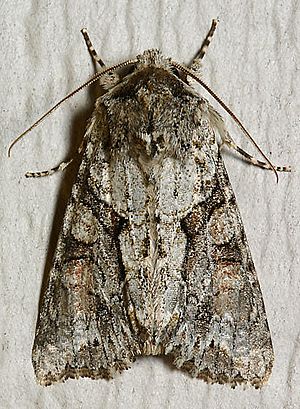Distinct quaker facts for kids
Quick facts for kids Distinct quaker |
|
|---|---|
 |
|
| Scientific classification | |
| Kingdom: | |
| Phylum: | |
| Class: | |
| Order: | |
| Family: | |
| Genus: |
Achatia
|
| Species: |
A. distincta
|
| Binomial name | |
| Achatia distincta Hübner, [1813]
|
|
| Synonyms | |
|
|
The distinct quaker (scientific name: Achatia distincta) is a type of moth that belongs to the Noctuidae family. It was first officially described by a scientist named Jacob Hübner in 1813.
Contents
Meet the Distinct Quaker Moth
This moth is known for its unique appearance, which is why it's called "distinct." It's a fascinating insect that plays a role in its ecosystem.
Where Does It Live?
You can find the distinct quaker moth across most of the United States, from one coast to the other. It also lives in southeastern Canada, specifically from Quebec all the way to Manitoba.
What Does It Look Like?
The distinct quaker moth has a wingspan of about 30 to 37 millimeters. That's roughly the length of two standard paper clips placed end-to-end! Adult moths are usually seen flying from late March to early May.
Life Cycle of the Moth
These moths have one generation each year. This means that from egg to adult, their entire life cycle happens once within a 12-month period.
What Do They Eat?
When the distinct quaker moths are in their larval stage (meaning they are caterpillars), they enjoy munching on the leaves of various trees and plants. Their favorite foods include:
- Ash trees
- Birch trees
- Butternut trees
- Flowering crabapple trees
- Grapevines
- Hickory trees
- Maple trees
- Oak trees

